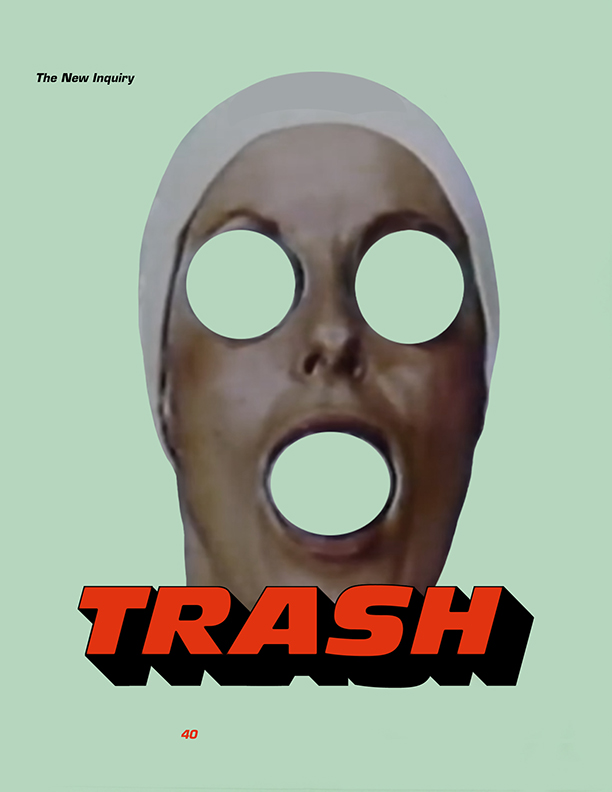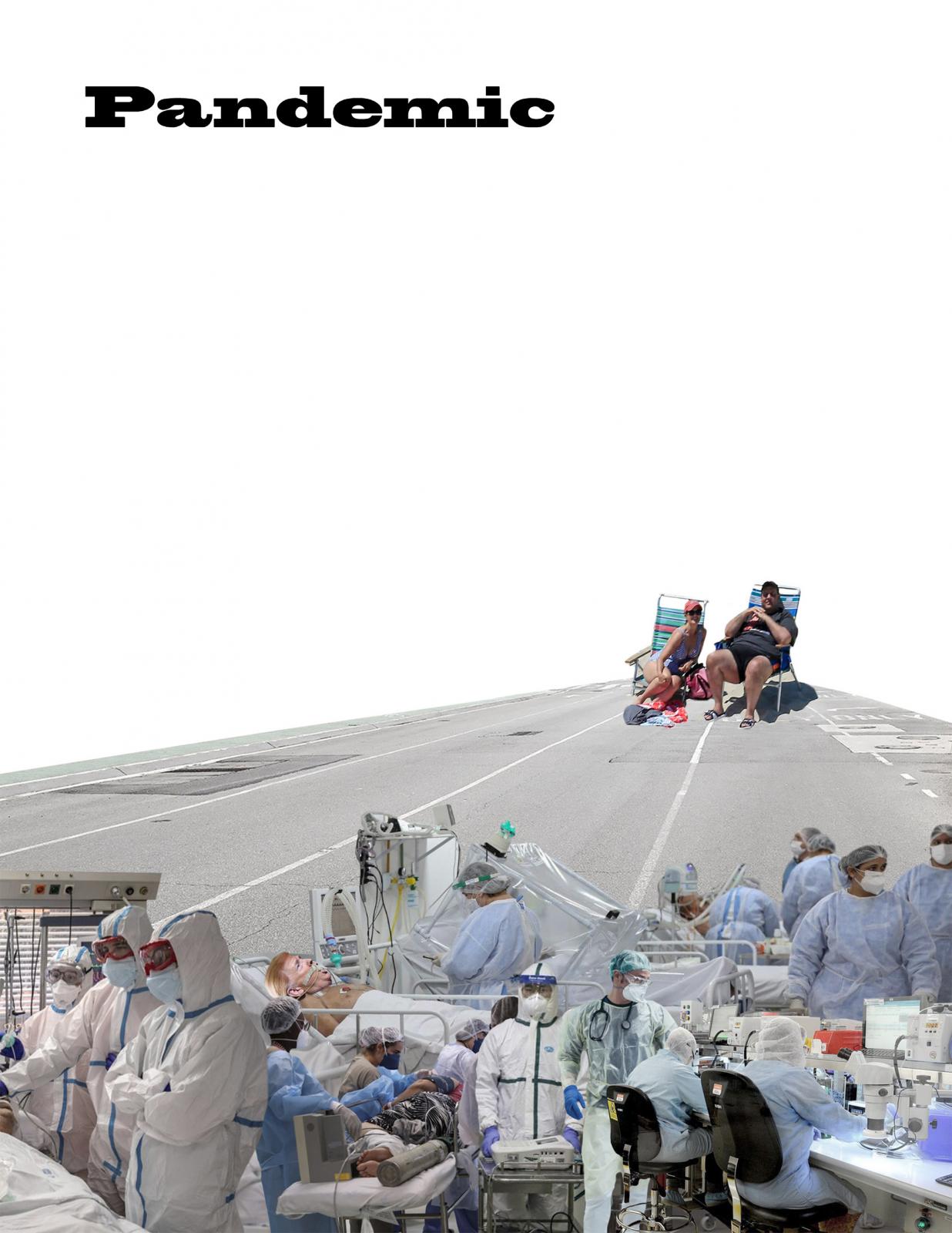Trash
Editors' Note
Of the total materials that flow through the US’ production and distribution processes every day, 99% will be waste within six months. Half of the food produced in the United States is thrown out, two thirds of that before it even reaches the point of consumption. In a real, material sense, capitalism doesn’t produce goods nearly so much as it produces trash.
Images of this garbage system’s extremes proliferate: children’s fingers picking through electronic waste in search of rare earth, an oceanic plastic-bag gyre five miles wide, a bulldozer reducing a slum into rubble, a lake of excreted industrial chemicals transforming acre upon acre into black sludge. The circulation and consumption of these images—as well as the affect of outrage they are designed to create—are themselves the products of generalized disposability and obsolescence.
But if this points to one of capitalism’s great innovations—that waste-creation is not only an acceptable but a desirable method of profit production—capital’s defenders have always pretended exactly the opposite, extolling efficiency and precision, telling the poor that to waste not is to want not. The capitalist world is built on a giant mound of garbage, but bourgeois nostrils insist on not inhaling the stink. Such standards of cleanliness and order have always required someone else’s hands getting extremely dirty.
Why do the bourgeois, propelled into greater and greater wealth by faster and faster production of waste, find it so distasteful? Perhaps in the uselessness of trash they sense the potential of a life outside of the market’s purview, one lived unproductively and for itself. Maybe it reflects back to them their ultimate disposability, the mortality no wealth can fix. Or maybe they just see in it the shadow of the riotous populations they’d just as soon forget their wealth is built upon.
As automation and waste increases, so too do “surplus populations,” those outside or on the margins of production circuits who so often populate and pick through the sites of literal and figurative waste disposal. The regimes of gender and race, too, increasingly function to decide who is trash, throwing entire groups of people away into prisons, refugee camps, shanty towns, marriages or more invisible and dispersed forms of social isolation.
One condition of trash is that its perspective is illegible, its “speech” at best involuntary, merely a history of its being used and discarded. Abusers play on trash’s inability to narrate itself convincingly, turning their victims into trash in order to make them seem crazy and out of control. In Hot Allostatic Load, Porpentine traces her own experience of being made trash within “radical” queer and gaming communities. “Because every abuser throughout my life was so good at being believed, I thought that being believed was the exclusive domain of abusers.” she writes.
Abusers’ tricks suffuse the entire world, and one way of not letting that turn you into trash is to make a home in it. Oscar the Grouch, in Sam Keogh’s telling, teaches kids about the phenomena of antagonism, argument, and rudeness from his fetid can on Sesame Street. He is impervious to abuse — he revels in it — and doles cartoon doses of it out himself, but something about his lazily resolute opposition to social organization as such whispers that he’s on the right track.
In most instances, however, people ending up in the garbage is much more dire. When human bodies literally become refuse, it becomes a political struggle to insist on their being able to speak. Throughout the seventies and eighties, Augusto Pinochet’s regime murdered thousands of Chilean dissidents and disappeared their bodies, throwing many of them into rivers or oceans. To this day loved ones search for what fragmentary remains can be recovered from the water, hoping by physical evidence to prove Pinochet’s crimes and win justice, as Jenna Brager writes about in Bodies of Water.
The bodies of those who died in the Twin Towers, on the other hand, weren’t even located before they were being used to start wars. But how were they located? As Karla Cornejo Villavicencio demonstrates, the production of “9/11” as an instrument of governmentality and warmaking was premised on the gruesome and toxic physical excavation of the giant mound of debris that sat at Ground Zero. Looking for survivors in the rubble, the often undocumented laborers of “The Pile” mostly found disease, asthma, and led-poisoning. The state, meanwhile, discovered patriotic fervor and glorious justification.
While the memorialization of the Twin Towers’ debris allowed a recomposition of the national body, not all piles of waste have that power. For the less-loved but far more ubiquitous piles of trash, C. Greig Crysler and Shiloh Krupar propose a Museum of Waste. The team conducts a feasibility study for an institution which would present a critical architecture of trash, organized around capital, ecology, and sovereignty. “The waste that forecloses the future has become a site of super-profits in the present,” they write. Continuing on their tour of the museum, they pass a monumental pile of failed techno-fixes the feedback loops of capitalism try to employ to “black-box” waste and debris: 110-story LEED-certified skyscrapers and rechargeable cars.
The junked skyscrapers of the Museum of Waste could easily be sourced from any one of China’s rapidly-developing cities. In an excerpt from his book Ghost Cities of China, Wade Shepard sketches the material extent of the modern Chinese construction boom. 40 percent of the land for new buildings is created by tearing down old ones, and the average building only has between twenty-five and thirty years to stand before it’s scrapped in favor of development that can command a higher price. This leads to massive amounts of construction waste; in 2011 alone, 2 billion tons of building materials ended up as trash, most piling up on the outskirts of cities, “showering residents with dust whenever the wind blew.”
The abandoned or trashed buildings of London, however, are repurposed into spaces of community by African Christian worshippers, writes Sara Bivigou, an ex-congregant. She affectionately calls them “trash spaces” because they look as though they’ve been thrown away, but instead have been dusted off and put to use. One neighborhood in London has the highest concentration of African churches outside the continent itself. These spaces reflect a self-conscious relation to the city as immigrants. “By committing to these places we are showcasing a specific vulnerability, we’re showing what we lack,” she writes. “These are the places we hoard our hope.”
While the majority of the people alive are treated like trash to maintain the profit-seeking world, the centrality of actual garbage to the circuits of profit and production can be seen as a promise of the restoration of otherwise trashed people to the center of the human community. In other words, the ubiquity of trash in capitalism is a material promise that the waste product at the top will soon be consigned to the dustbin of history.
Featuring
-
Editors' Note, Vol. 40: Trash
-
Hot Allostatic Load
-
Bodies of Water
-
The Grouch
-
Blood and Glory
-
MoW Memorandum
-
City of Praise
-
Demolition Party





